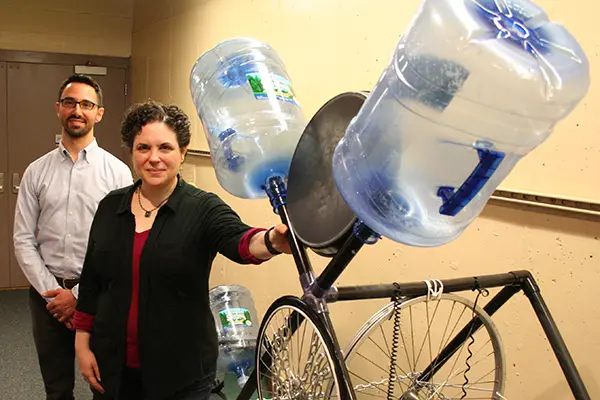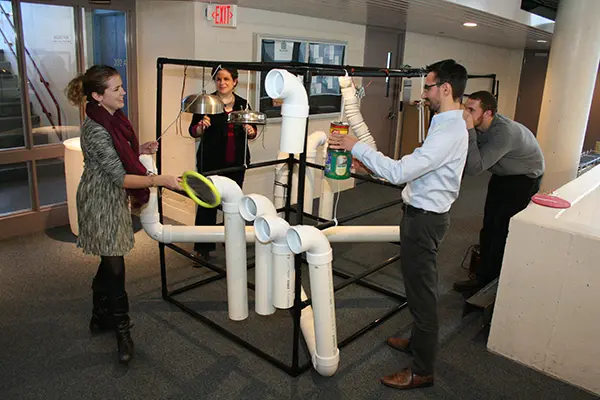EcoSonic Playground Teaches Children STEM Skills, Fosters Musical Creativity
 Image by Ed Brennen
Image by Ed Brennen
12/14/2016
By Ed Brennen
Whether it’s a 3-year-old pulling out pots and pans onto the kitchen floor for a rousing drum solo or a kindergartner making like Dizzy Gillespie with a cardboard paper towel tube, musical play is a natural part of childhood.
Asst. Prof. Elissa Johnson-Green of the Music Department researches musical play from a sociological perspective, looking at how people interact with music “as a basic function of humanity.”
Her latest research project, the EcoSonic Playground, seeks to encourage musical play for children in underserved communities by helping them create their own unique music-making structures, using mostly recycled materials. The initiative includes a curriculum component for elementary schools to teach students STEM skills through lessons in acoustics, physics, engineering and design as they work with educators to build the structures themselves.
“We know that when kids live in a stressful environment, it arrests their development. And we know that music accelerates the process of development. So the idea is to see how these children are developing once they have an opportunity to have musical play every day,” says Johnson-Green, who is collaborating on the project with visiting lecturer Christopher Lee and senior music education major Tyler McMillan, a member of the Emerging Scholars program.
The team is working with Lowell’s Lincoln Elementary School to develop an after-school pilot program for the project this spring. Once Lincoln’s structure is complete, the researchers hope to expand the project to other schools in the city and beyond.
“I think the most important aspect of this is to make these available to communities that might not otherwise have a lot of opportunity for music or play,” says Lee, a composer and music theorist who appreciates the cross-disciplinary aspect of the project. “It touches on a lot of subjects, but the social justice and ecological sustainability aspects are very important to me.”
 Image by Ed Brennen
Image by Ed Brennen
Johnson-Green’s team has built two prototype structures: one consisting of three bicycle wheels, four Poland Spring water jugs and a gutter downspout, and the other made up of 10 PVC pipes, two coffee cans and a pair of metal cooking pot lids. The curious-looking contraptions have been set up on the second floor of Durgin Hall, where the researchers are observing how UMass Lowell music students interact with them to inform future designs.
After a recent evening performance at Durgin Concert Hall, McMillan says a group of students discovered the structures and began to see what kind of sounds they could make. Martha Robertson, a senior music education major who is also involved with the project, recorded the scene with her phone’s camera.
“Some students started playing on them, and the next thing you knew they had a spontaneous two-hour jam,” McMillan says. “Someone pulled a piano over, but they were making the majority of the music just with the structures.”
That was music to the ears of the researchers, who are seeking grant money for the next phase of the project: creating permanent versions of the portable structures designed by kids.
“They would be more like the structures you see on most playgrounds,” says Johnson-Green, who applied for a National Endowment of the Arts grant over the summer (to be announced in April). “We would take those designs to an architect, go to the city planning office, do all the due diligence to get it built, but we wouldn’t ask for money from the school. That would defeat the purpose of this project.”
 Image by Ed Brennen
Image by Ed Brennen
The researchers also took part in the university’s recent National and International Partnerships in Sustainability Workshop, where they collaborated with visitors from Trinity College in Dublin on ways to re-create the project in Ireland. Together, they’ve applied for a piece of the workshop’s $20,000 in grant money funded by the UMass President’s Office.
“We talk about this project a lot ourselves, but the only way we’ll ever know if it’s actually a good project is if we go out and see what other people think,” says Johnson-Green, who adds that sustainability is the centerpiece of the project curriculum. “We want to teach kids how to be adaptive in their environment and give them the ability to go out in their community and use sustainable materials to create whatever they need.”
And for UMass Lowell students like McMillan, the project is an opportunity to explore disciplines outside the music world.
“I’ve had the opportunity to look into environmental sciences, sustainability and engineering,” McMillan says. “I even learned how to use power tools for the first time, which was excellent.”
